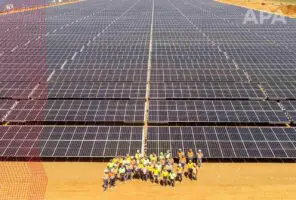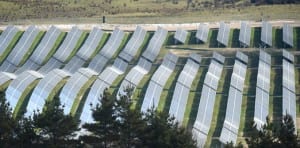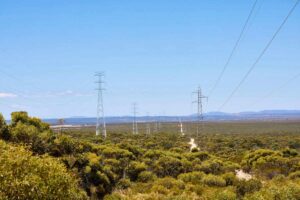Australia’s major electricity utilities are acting to brake or even halt the rapid uptake of solar PV – pushing for higher network charges, refusing connections and downsizing rooftop proposals, as well as removing discounts and forcing tariff changes on solar consumers.
The push to contain the rush for solar PV – which is occurring even after most subsidies have been removed – comes as major generators, network operators and electricity retailers admit that solar PV is upsetting their decades-old business model – which is based on a high-volume, low margin business that relies on continued growth.
The latest example comes from the Australian Energy Market Commission, the body that forms policy on behalf of the incumbent players, which canvasses higher charges to the more than one million households, and a growing number of businesses, that install solar PV systems.
AEMC chairman John Pierce on Wednesday unveiled a “strageic priorities” document that highlights solar PV as one of the most pressing issues for the electricity industry – both for providers and consumers – and suggests that network tariffs in particular do not reflect the reduced use of the grid caused by solar households.
“Distributed generation is blurring the traditional delineation between consumers and producers of electricity,” Pierce said in a speech to the East Coast Energy Outlook conference in Sydney
“One source of stakeholder concern is that network costs of consumers with rooftop solar PV are subsidised by other consumers because the full costs and benefits of distributed generation (such as solar PV) are not reflected in the prices consumers pay for electricity.”
The solar industry is outraged by the singling out of solar, because they say it is clear that the greatest cross subsidy in the electricity industry goes to users of air-conditioners: The government white paper conceded that each $1,500 air con system imposes five times that amount in network costs on other users.
However, the incumbent industry has not complained about that, because air-conditioners add to demand, and increase the incentive to make more investments (in poles and wires and generation) and increase revenue – even if the customer ends up paying through much higher network charges.
However, solar PV subtracts from demand and challenges that business model. This raises the question of equity. Network operators, despite having over-invested in a network, want the right to claw back that investment. Social equity goups are anxious that low income households are not burdened with increased cost. The solar industry, and its burgeoning solar constituency – which now numbers nearly 3 million people across the country– does not want to be unfairly targeted. The solar industry also points to the $1 billion in annual cross subsidies to support grids in regional Queensland and Western Australia.
“This is pretty outrageous,” said Muriel Watt, the chairperson of the Australian Photovoltaic Association. “We cannot have a regulatory system where every perturbation to the ‘norm’ is hit with a new charge.
“What will happen with EVs, storage, net zero energy houses (even with no PV), and any other new technologies that come along? We need to develop a regulatory framework that deals fairly with all supply and demand on the grid and where those who contribute more to the costs of that grid pay more.”
Solar PV – along with battery storage and energy efficiency – is emerging as the defining issue for the electricity industry across the globe.
In the same conference that Pierce addressed, a US energy consultant, Fereidoon Sioshansi from Merlo Energy, said the electricity industry in the US recognised that it may already be too late to save their business.
It was becoming obvious that consumers were finding it cheaper to supply their own energy than to rely on the grid. He pointed to the millions of people world-wide who no longer use land lines for telecommunications.
Still, utilities in Australia are trying to push this inevitability as far back as possible. In the absence of an alternative business model are relying on regulatory protection, supported by the degree of regulatory capture to protect their business models.
There is increasing evidence that utilities across Australia are refusing solar connections, or forcing solar users to change tariffs in an attempt to make the uptake of solar less attractive.
Green MP Greg Barber raised the issue in Victorian parliament last week, citing 22 instances in western Victoria where he said the local distributor Powercorp had either rejected outright applications by homes and rural businesses to install solar, or had forced the array to be downsized.
An application for a 30kW system in Warrenheip was approved only for 15 kW, an 8kW proposal in Invermay was refused in total, an 8kW array in Rockbank was downsized to 3kW, and a 6kW proposal in Amphitheatre was downsized to1.5 kW.
Barber called on the Victorian government to publicly release all information about the supposed limitations on the grid that it has used as an excuse to oppose these solar panel installations.
He also called for a regulatory test each time a distribution businesses wants to spend $1 million or more upgrading the grid, so that alternatives such as solar panel, combining those with battery storage and energy efficiency could be evaluated.
“The Liberals seem to love red tape when it gets in the road of renewable energy development,” Barber told parliament. “They are back there providing a backstop for the coal industry every time one of these renewable energy developments gets pushed away, knocked back or enormous cost through red tape is added onto it, and it is about time that the private monopoly power companies were brought under control by this minister through the legislation that he already controls.”
In WA, solar companies say potential clients are being penalised for putting in PV, because utilities we deal are forcing customers to renegotiate their tariffs before allowing them to install in PV. They call is “unbundling”. It basically sets higher fixed charges and lowers the kWh rate and negates and financial benefits of going solar.
“It’s incredible! “said one installer, who asked not to be named. “ Not only does this knock down the value of solar, but energy efficiency measures will be affected as well. It’s blatant and it’s showing utilities need to respond with drastic measures to keep their profits based on business as usual.” It is believed that the solar industry is to hold a meeting with WA utilities next week to discuss the issue.
In NSW, there are reports from advocacy groups that solar installers that households wanting to install solar being denied discounts offered to general consumers.
The AEMC paper says the increase in rooftop solar PV was one of the most frequently raised topics in stakeholder workshops and submissions. Two common issues were the structure of network tariffs and the impact on the network costs paid by those with and without solar, and the subsidies, such as feed-in tariffs, for renewable energy, and the “inequity” of cross-subsidisation across consumers with and without solar PV. There was a concern that solar users would use the grid as a cheap battery.
There has been discussion about increased fixed charges, but some in the industry recognise that this will simply remove the incentive to conserve energy, be efficient and will just inspire more people to leave the grid.
Others are pointing to a new idea surrounding the “capacity” of a “pipe” that would link consumers – households or businesses- to a grid. This would limit consumption, but would reward those who chose not to use the grid as much, and put appropriate charges on those – with huge demand from air-con and pool pumps – that consume large amounts.
The solar industry is drawing to a similar conclusion that network tariffs need to be reframed, but not necessarily in the manner suggested. It is working on a study that will show that solar PV can actually reduce costs in some areas, and overall would add a minimal amount of grid costs on the average consumer.








